If you spend countless hours refining your accuracy at the range or tracking game through thick backcountry, you already know how essential a solid, stable shooting platform is. That’s where the best rifle bipods come in. They give you the steady rest you need in prone or sitting positions, whether you’re coyote hunting at dusk or practicing long-range shooting for competitions.
In this blog, I’ll share our firsthand experiences and insights on the top bipods ranked today. We’ll also compare their features, dig into mounting systems like Picatinny rails or sling swivel studs, and highlight which bipods work best for specific rifles, think AR15, AR10, Tikka T3x, or even a classic hunting rifle that doesn’t have a rail at all.
We’ve tested these bipods in real-world settings, from breezy open fields in the U.S. Midwest to damp forests in the UK. This journey has taught me that even a slight difference in leg extensions or bipod locks can transform your shooting experience. So let’s cut to the chase and answer a few questions right off the bat.
Are you in a hurry? The short answer is that a good bipod should be stable, easy to install, and adaptable for various shooting styles. If you need quick recommendations, head down to our Comparison Table below.
Read on for detailed product reviews, a thorough buying guide, and answers to some hard-hitting questions about accuracy, best bipod height (12-27″), and more. If you’re looking for other gear to complete your setup, feel free to check out more reviews on Gunners’ Review.
Each of these bipods has been mounted on rifles for real shooting sessions, both recreational and serious. We’ve tested them prone, sitting, and sometimes kneeling, to see how they handle different scenarios. The order runs from budget-friendly to premium picks. Prices can shift, but the overall bracket remains consistent.
Comparison Table | Best Rifle Bipods
| Rank | Name | Mounting | Height Range |
| 1. | CVLIFE | Picatinny Rail | 6-9 inches |
| 2. | Magpul | M-LOK / Picatinny Versions | ~6.3-10.3 inches |
| 3. | Caldwell | Sling Swivel Stud | 6-9 inches |
| 4. | Feyachi | Barrel Clamp / Rail Adapter | 6.5-7 inches |
| 5. | Vanguard | V-Shaped Rotating Yoke | Up to 62 inches |
| 6. | Xaegistac | M-LOK | 5.7-8 inches |
| 7. | UTG | Keymod | 5.7-8 inches |
| 8. | Accu-Shot | Picatinny Rail (ADM QD) | 5-9 inches |
| 9. | Harris Engineering | Sling Swivel Stud | 6-9 inches |
| 10. | CVLIFE | M-Rail (M-LOK) | 6-9 inches |
| 11. | Javelin Spartan Precision Equipment | Spartan Mount (RRS/Arca Adapter) | ~6.5-9.5 inches |
| 12. | Harris | Picatinny Rail | 6-9 inches |
| 13. | MDT | RRS/Arca Mount | Varies (Triple Pull) |
CVLIFE
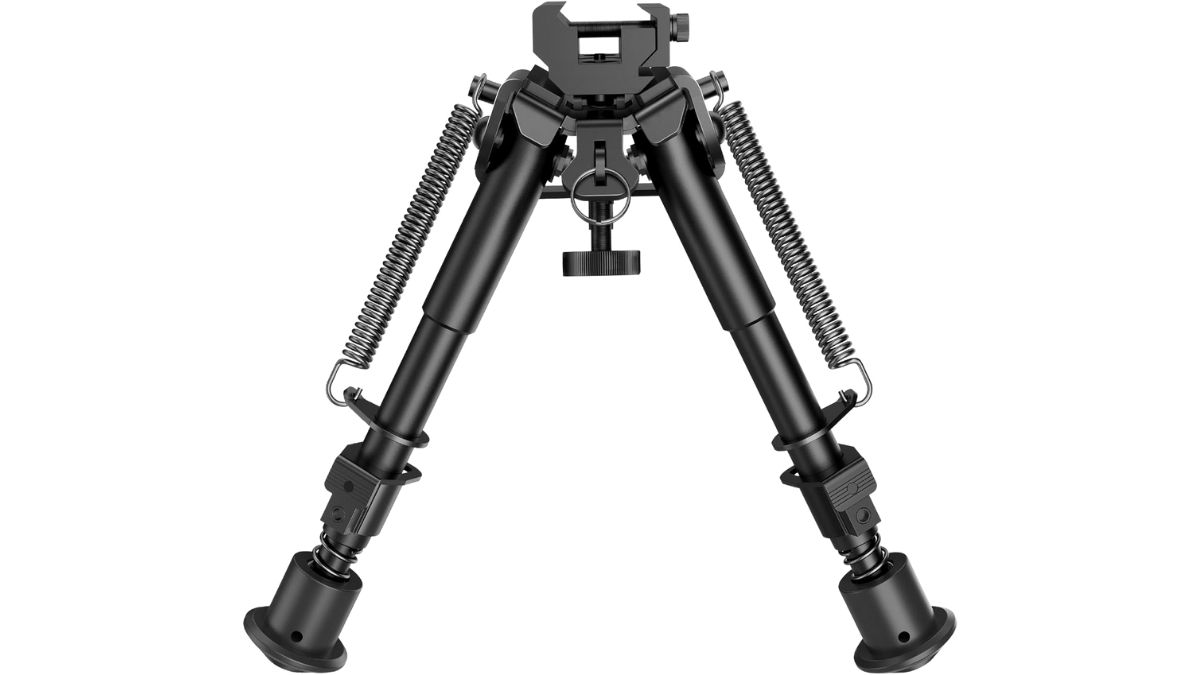
Pros
- Very affordable, often under $30 (Under $100 category).
- Spring-return legs make adjustments quick.
Cons
- Limited tilt functionality.
- Not the most durable in extreme conditions.
Key Specs
- Mounting System: Picatinny Rail
- Height Adjustability: 6-9 inches
- Weight: ~10 oz
We started using this bipod on an AR-15 for casual range days. It comes with a Picatinny adapter and sets up easily. The spring-loaded legs don’t have the silky smooth feel you get from premium bipods, but they’re reliable enough for general hunting rifle tasks or even coyote hunting if you’re on a tight budget. For coyote stands where you’re typically in a prone position, a 6-9 inch height often works fine. If you need a rock-solid pivot, you may want something else, but for an affordable, functional bipod, the CVLIFE does the job.
Caldwell
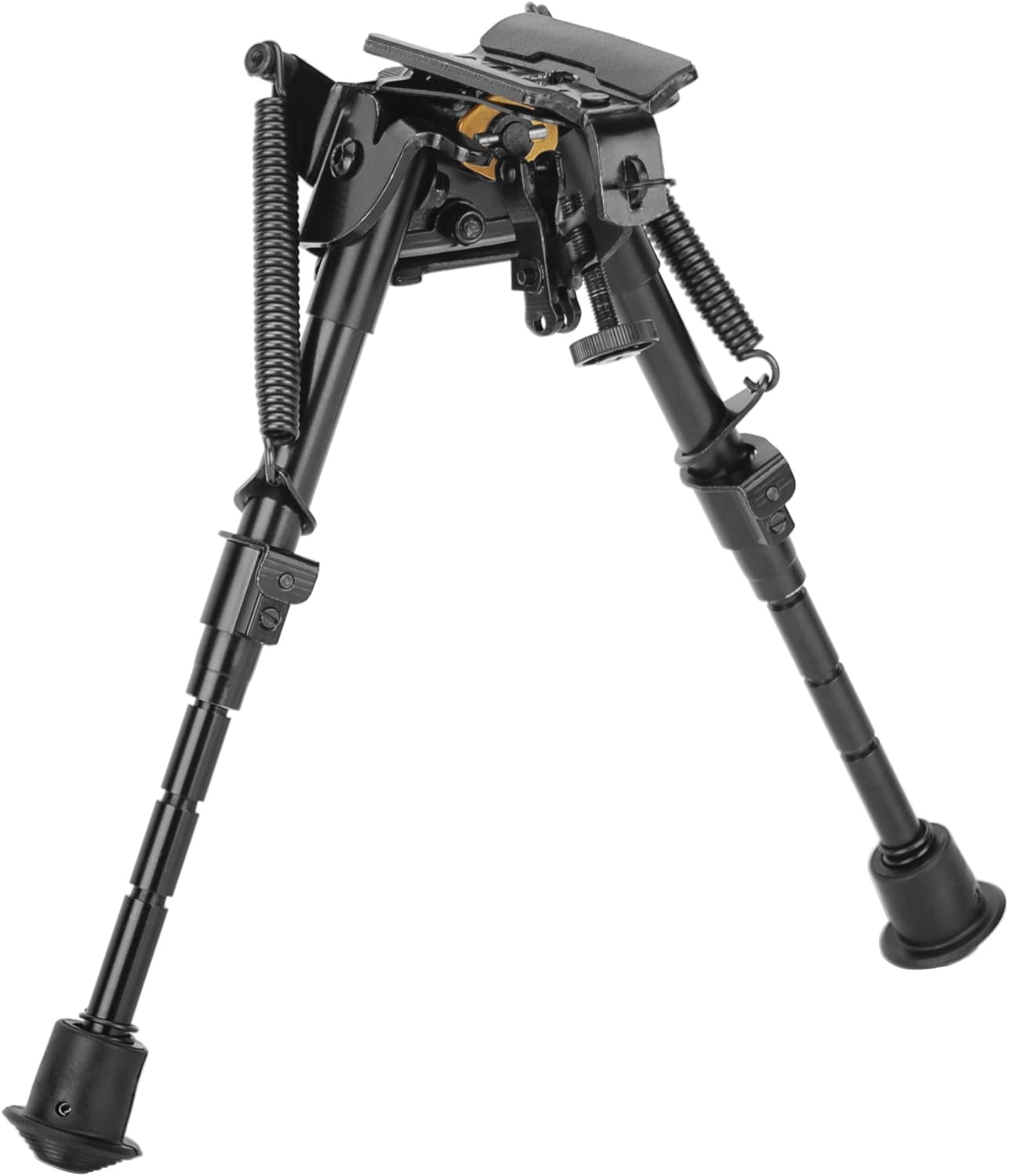
Pros
- Sling swivel stud attachment is simple.
- Pivot feature helps level on uneven ground.
Cons
- Plastic knobs feel a bit fragile.
- Leg extension notches can be slow to deploy compared to spring-loaded designs.
Key Specs
- Mounting System: Sling Swivel Stud
- Height Adjustability: 6-9 inches
- Weight: ~11-12 oz
If you have a rifle without a rail, like a classic deer hunting setup or Tikka T3x, this bipod is a decent choice. Its pivot feature is a lifesaver on rough terrain, letting you keep the crosshairs steady. However, adjusting the leg lengths can feel stiff if you’re used to spring-loaded bipods. We used the Caldwell XLA during a turkey hunt in the United Nations, where the muddy fields made a level bipod critical. It’s not fancy, but it’s dependable for moderate-range shooting.
Feyachi
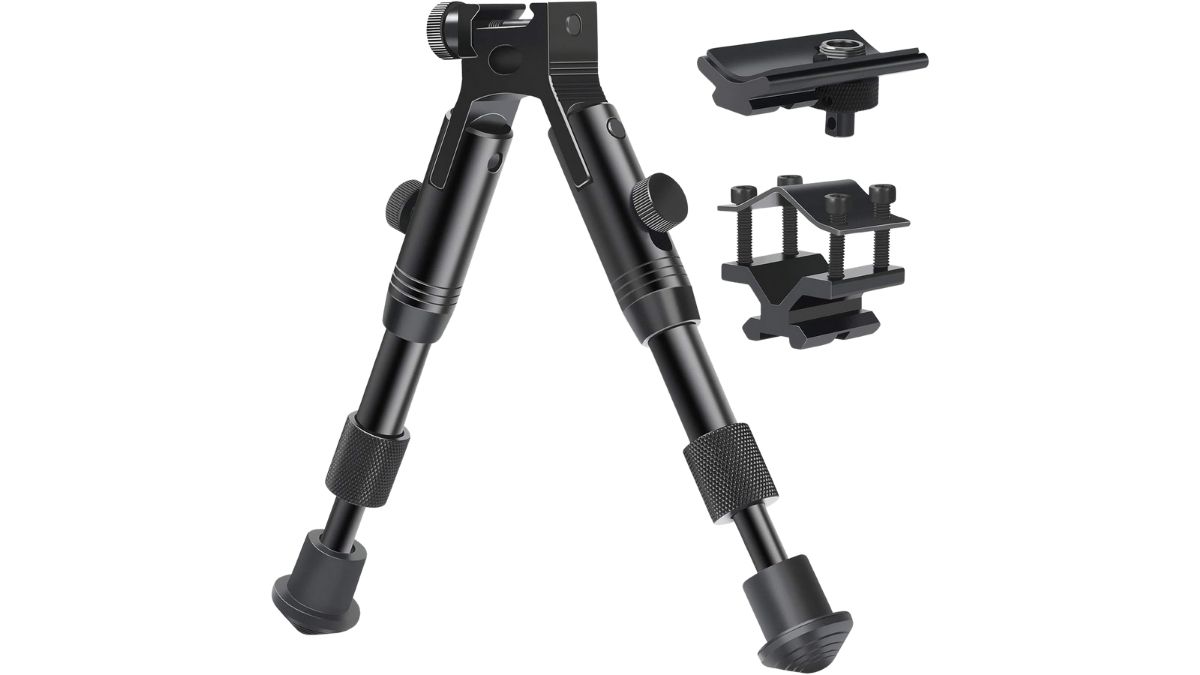
Pros
- Comes with multiple mounting solutions (barrel clamp, rail adapter).
- Compact and easy to stow away.
Cons
- Barrel clamp can shift if not tightened correctly.
- Height range is minimal (6.5-7 inches).
Key Specs
- Mounting System: Barrel Clamp or Picatinny
- Height Adjustability: 6.5-7 inches
- Weight: ~12 oz
The Feyachi 3-in-1 is for anyone who isn’t sure which mounting style they need. I tested it briefly on a .22 rifle for recreational plinking and found it stable enough for casual use. If you’re heading into rugged or wet conditions, double-check the barrel clamp tension because any slight shift can throw off your aim. This is more of an entry-level choice for a best rifle bipod for hunting or target practice, but it might not be ideal for demanding, long-range shooting tasks.
Xaegistac
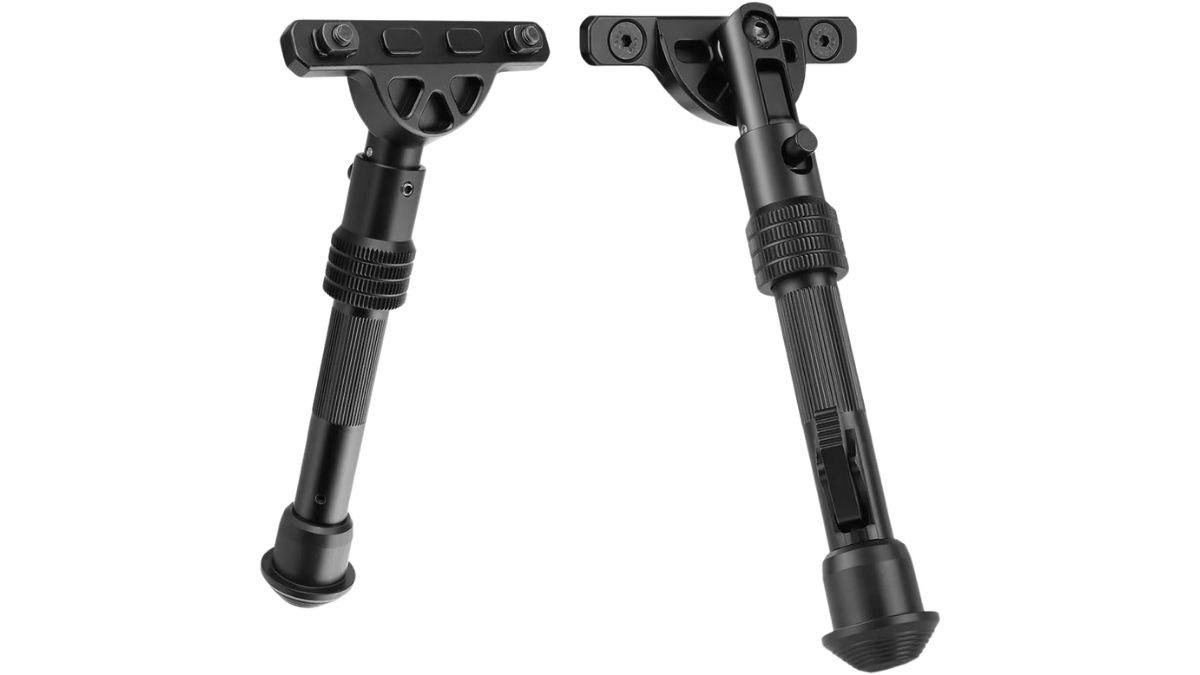
Pros
- Super compact footprint.
- Lightweight (only ~9 oz).
Cons
- Leg extensions aren’t as tall as other bipods on the market.
- Limited panning or canting ability.
Key Specs
- Mounting System: M-LOK
- Height Adjustability: 5.7-8 inches
- Weight: ~9 oz
For an M-LOK setup on something like a smaller AR-15, we found the Xaegistac convenient for bench shooting at shorter ranges. It’s sturdy enough for .223 and .308 rifles. The short leg range suits prone shooting but might not give you enough clearance for a sitting position, especially on uneven terrain. If you’re searching for a simple, budget-friendly bipod that doesn’t add much weight to your rifle, this is a solid option.
UTG
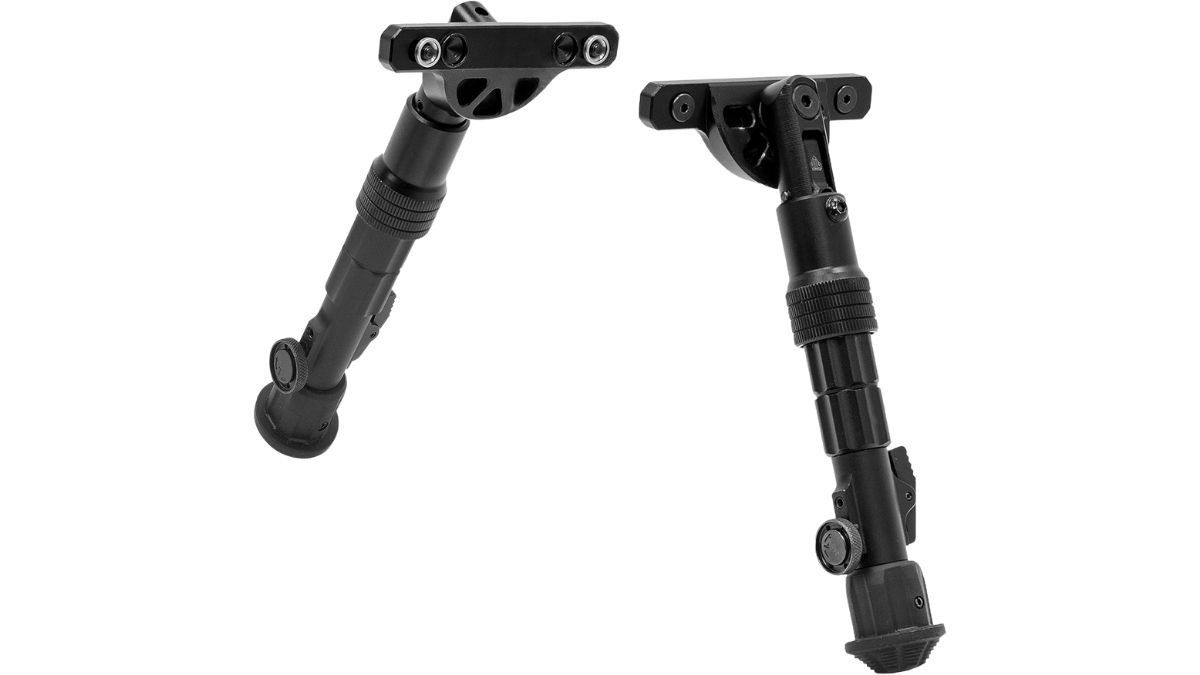
Pros
- Keymod-specific attachment for direct mounting.
- Low-profile, no extra adapter needed if your handguard has Keymod slots.
Cons
- More specialized mounting (Keymod only).
- Legs can be a bit stiff to fold initially.
Key Specs
- Mounting System: Keymod
- Height Adjustability: 5.7-8 inches
- Weight: ~12 oz
Our Keymod handguard AR10 paired well with the UTG Recon Flex. This bipod feels stable under recoil, and the legs don’t wiggle around, so it’s great for long-range shooting practice. However, it’s not universal. If your rifle is strictly Keymod, you’ll love how flush this sits on the handguard. But if you ever switch to M-LOK or an ARCA rail, you’ll need a different bipod.
Magpul
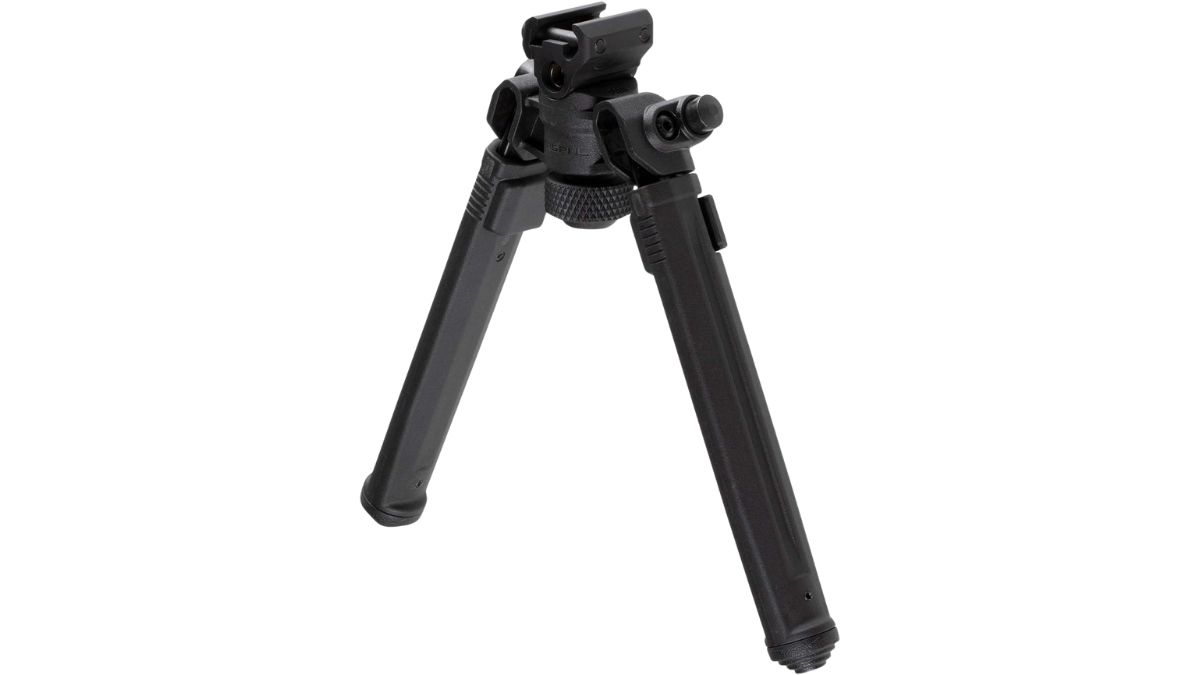
Pros
- Lightweight, mostly aluminum construction with polymer components that hold up in harsh conditions.
- Intuitive design that makes leg deployment and adjustment straightforward.
- Available in different mounting configurations (M-LOK or Picatinny), so it can fit a wide range of rifles.
Cons
- Slightly pricier than budget bipods, though still in the mid-range category.
- Legs can feel a bit stiff when brand-new; they loosen with use.
Key Specs
- Mounting System: M-LOK or Picatinny (model-dependent)
- Height Adjustability: Approx. 6.3 to 10.3 inches
- Weight: ~11 oz
We’ve run the Magpul bipod on both an AR-15 and a Tikka T3x, and it has proven to be one of the most user-friendly models out there. It’s especially handy if you’re frequently switching between prone and bench-rest shooting. The bipod locks into place with minimal wobble, and the leg extensions feel precise once you’ve broken them in. We’ve also dragged it through muddy fields in the UK and dusty ranges in the U.S., and it never seized up or corroded. If you’re after a solid, mid-priced bipod for hunting or recreational use, this is a very reliable pick.
CVLIFE
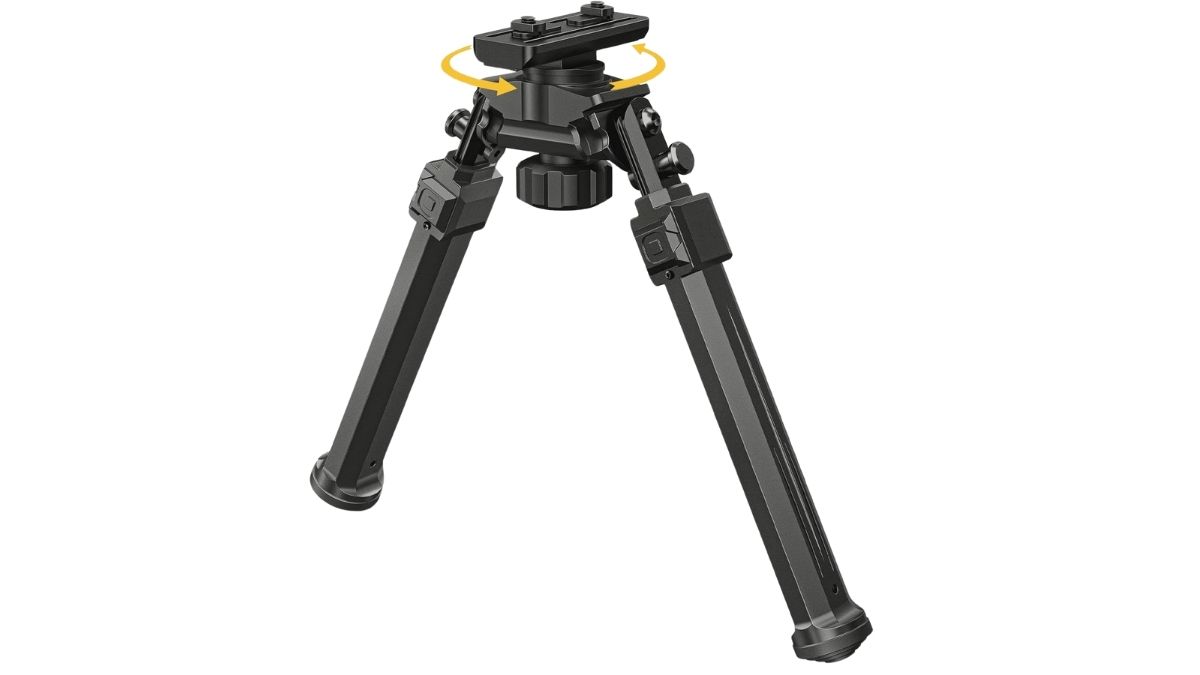
Pros
- Another solid budget pick from CVLIFE.
- Sturdy steel and aluminum blend.
Cons
- Similar design to the standard CVLIFE, so no pivot or pan.
- Tension knobs can loosen over time.
Key Specs
- Mounting System: M-Rail (M-LOK)
- Height Adjustability: 6-9 inches
- Weight: ~10 oz
This bipod is basically a variant of CVLIFE’s standard Picatinny model but made for M-Rail systems. If your hunting rifle has an M-LOK fore-end, this is plug-and-play. We found it decent for varmint hunting. At the range, it absorbs minor recoil well enough. It won’t blow your mind with advanced features, but it’s cost-effective if you just need something reliable to rest on.
VANGUARD
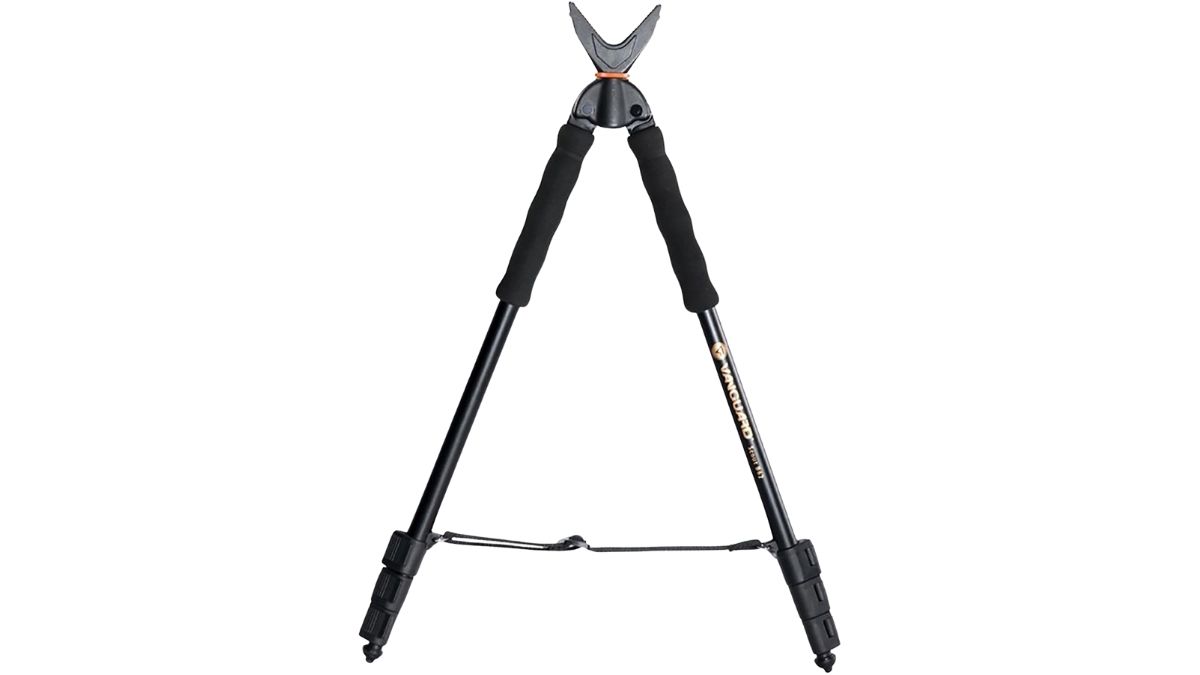
Pros
- Height can extend up to 62 inches for a comfortable sitting or kneeling position.
- Foam handgrips are comfortable for quick repositioning.
Cons
- Heavier (~22 oz) than most smaller bipods.
- Slower to deploy if you need rapid shots.
Key Specs
- Mounting System: V-shaped yoke clamp
- Height Adjustability: ~22 inches to 62 inches
- Weight: ~22 oz
For those times when you need the best bipod for sitting position, especially in open fields, the Vanguard Scout B62 saves you from hunching over. The V-yoke accommodates different rifle widths, so it’s not limited to one brand. We’ve used it for predator hunts (coyote and fox) where tall grass made prone shooting impossible. It also doubles as a solid walking stick in a pinch. The main drawback is that it’s not as compact as a standard bipod. But for all-around field use, it’s a versatile tool.
Harris
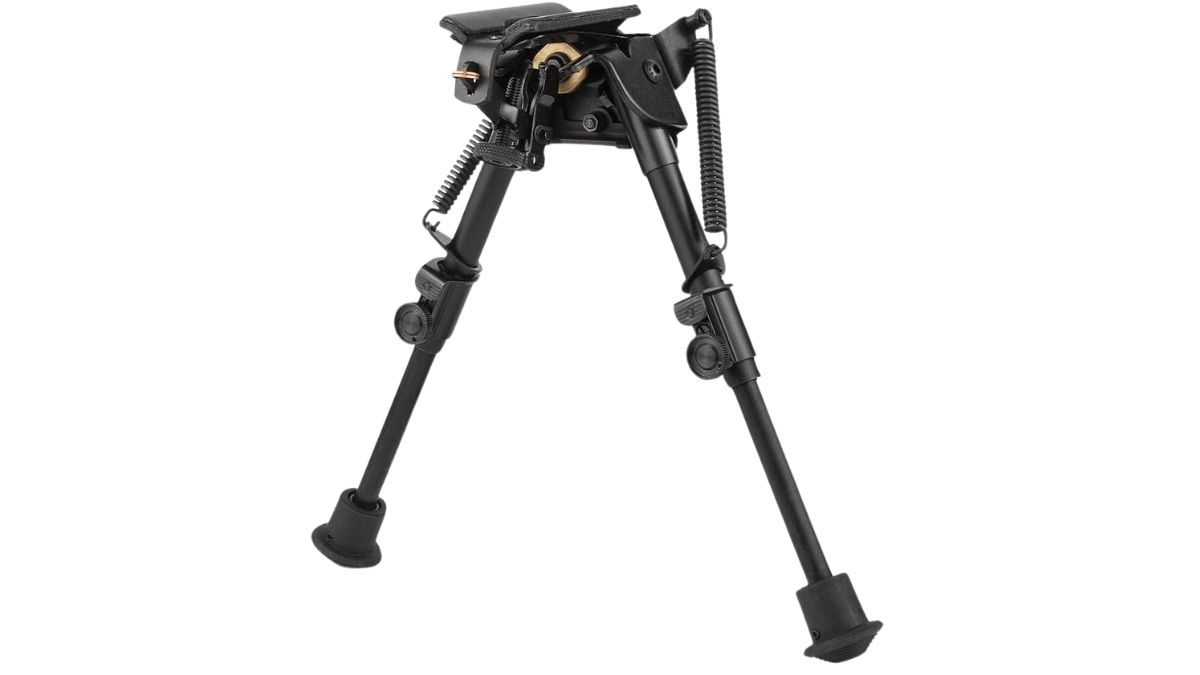
Pros
- Legendary Harris bipods reliability.
- Hinged base allows slight tilt.
Cons
- Sling swivel stud only, unless you get an adapter.
- Pricier than entry-level bipods.
Key Specs
- Mounting System: Sling Swivel Stud
- Height Adjustability: 6-9 inches
- Weight: ~11-13 oz
For many shooters, Harris bipods are the gold standard for a reason. They’ve been around for decades and have proven themselves for coyote hunting, range work, and serious competitive use. This S-BR model is sized for prone shooting but can also handle mild terrain changes thanks to the hinged base. If you own a Ruger Precision Rifle or a Tikka T3x, you might need an adapter for a Picatinny or ARCA rail. Other than that, it’s a great all-rounder. After using mine on a .308 bolt-action, I can confirm it’s as durable as people say.
Harris
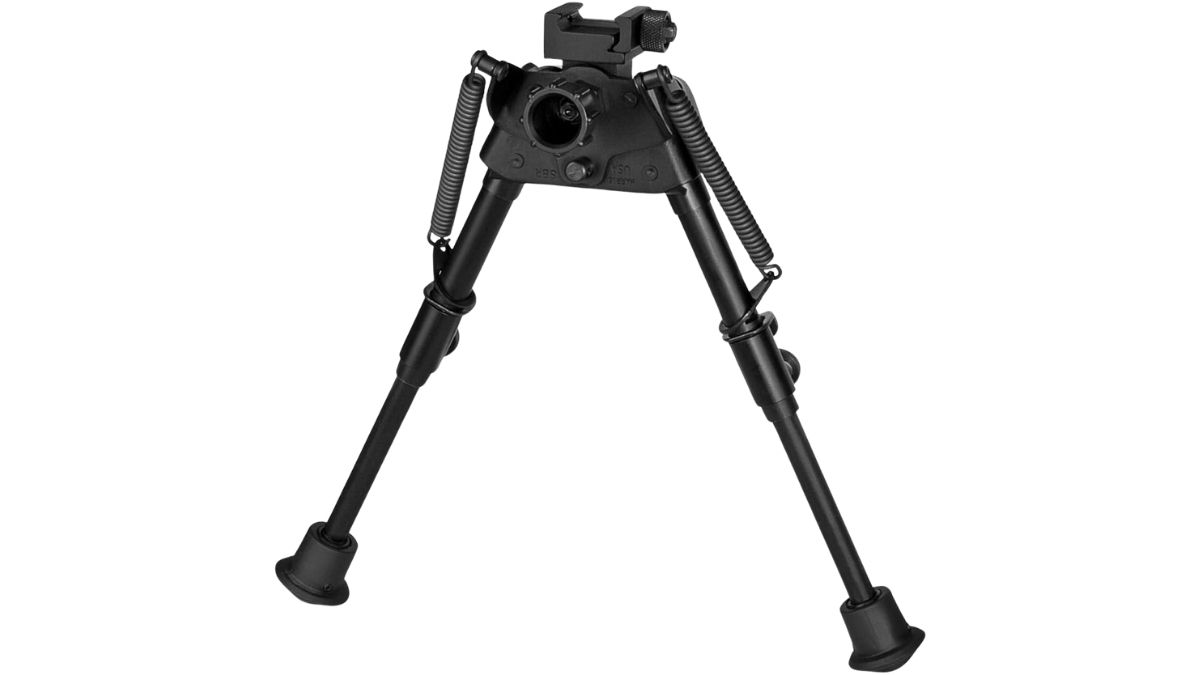
Pros
- All the Harris bipods quality plus a built-in Picatinny mount.
- Spring loaded for quick leg deployment.
Cons
- A bit heavier than the standard stud-mount versions.
- Cost can be borderline premium.
Key Specs
- Mounting System: Picatinny Rail
- Height Adjustability: 6-9 inches
- Weight: ~12-14 oz
This bipod is similar to the classic Harris design, but it comes ready for rifles with Picatinny rails (like an AR10 or specialized chassis systems). We’ve tested it on a .300 Win Mag with no problem. The bipod locks up tightly, and the leg notches are easy to engage. If you love Harris but don’t want to fuss with additional rail adapters, this S-BRP model is a straightforward answer.
Accu-Shot
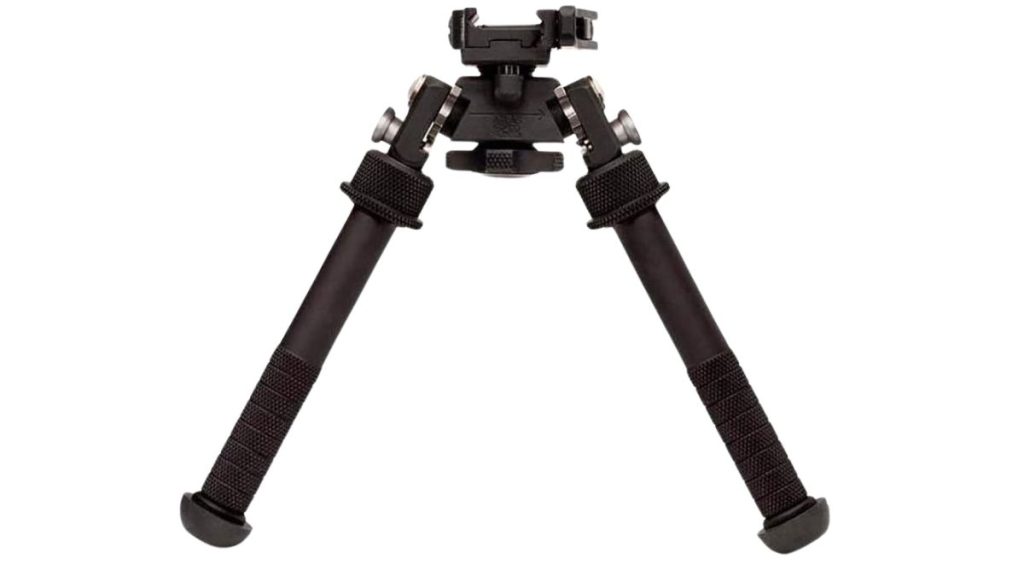
Pros
- Premium build quality, often seen in pro competition.
- Atlas PSR design allows precise panning and canting.
Cons
- Expensive.
- Overkill for casual plinkers.
Key Specs
- Mounting System: Picatinny (ADM QD mount)
- Height Adjustability: 5-9 inches
- Weight: ~12.7 oz
Atlas bipods have a stellar reputation in the precision rifle scene. We used the BT46-LW17 on an ARCA-compatible chassis for a long-range shooting event and were impressed by the smooth panning and “clicky” leg extensions. The QD lever is strong, making transitions between multiple rifles a breeze. This is for shooters who demand top-notch performance and don’t mind paying for it. If you’re looking for the best bipod for AR10 or other heavy-caliber rifles, the Atlas holds up with zero wobble.
Javelin Spartan
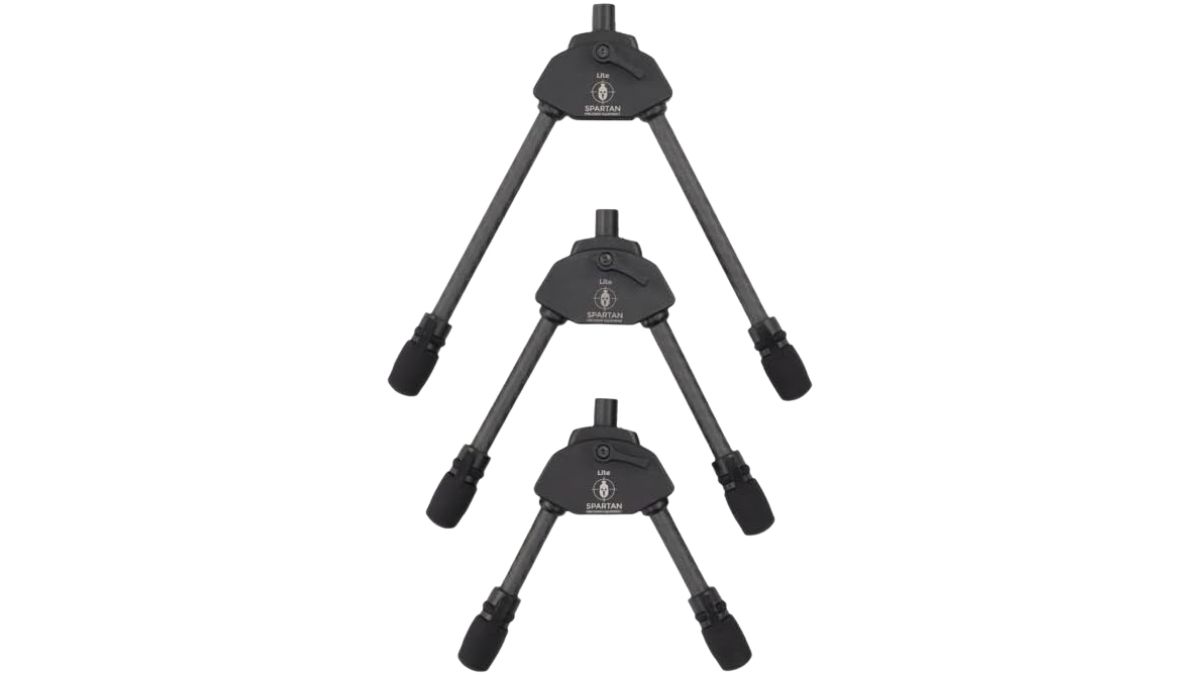
Pros
- Ultra-light carbon fiber design, perfect for mountain hunts.
- Rapid-detach system with RRS/Arca adapter.
Cons
- Premium price tag.
- May feel too minimalistic if you’re used to heavier bipods.
Key Specs
- Mounting System: Spartan Mount (Arca-compatible)
- Height Adjustability: ~6.5-9.5 inches
- Weight: ~5 oz (extremely light)
Spartan bipods are huge in Europe, particularly in the UK hunting community. We used one in the Highlands of Scotland during a red deer hunt. The carbon legs practically weigh nothing, and you can attach/detach them in seconds. For coyote hunting or any scenario where weight is a priority, it’s a dream. The only drawback is that it’s not cheap, and the minimalist design might surprise you if you’re used to bulkier bipods. But if you want something quick to stow and extremely light, this is an exceptional pick.
View Javelin Spartan on Amazon
MDT
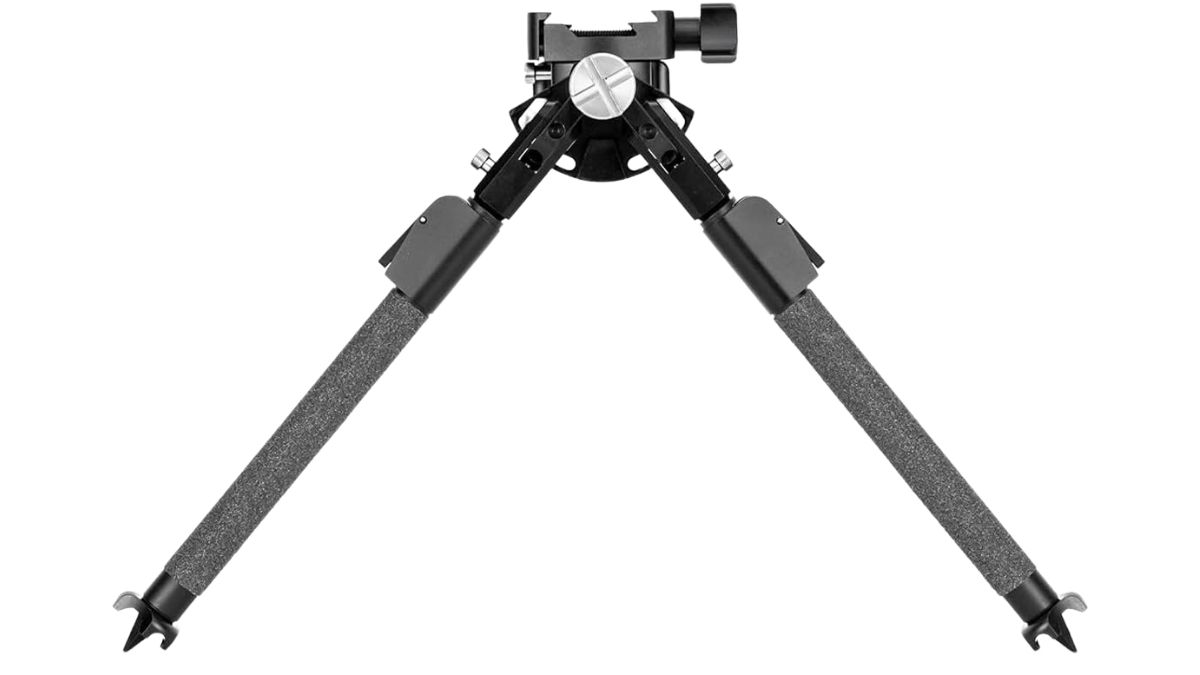
Pros
- Remarkable adjustability (triple pull legs).
- RRS BTC/Arca mount for advanced rifle chassis.
Cons
- Heavy (~18-20 oz).
- Price is top-tier.
Key Specs
- Mounting System: RRS/Arca
- Height Adjustability: Triple Pull (varies widely)
- Weight: ~18-20 oz
If you’re a precision rifle competitor, you’ve likely heard the buzz about the MDT Ckye-Pod. The triple pull legs provide unmatched customization on height, especially if you’re dealing with sloped or rocky terrain. We used one on my match rifle and found it stable even when pivoted to extreme angles. However, that extra steel and the complex locking system add weight. If you’re a serious competitor or an advanced shooter who values adjustability above all else, the Ckye-Pod should be at the top of your list.
Buying Guide: How to Choose the Right Rifle Bipod
A bipod isn’t just two legs under your rifle. It’s a critical piece of gear that affects your accuracy, comfort, and overall shooting confidence. To pick the best rifle bipods for your style, keep these points in mind:
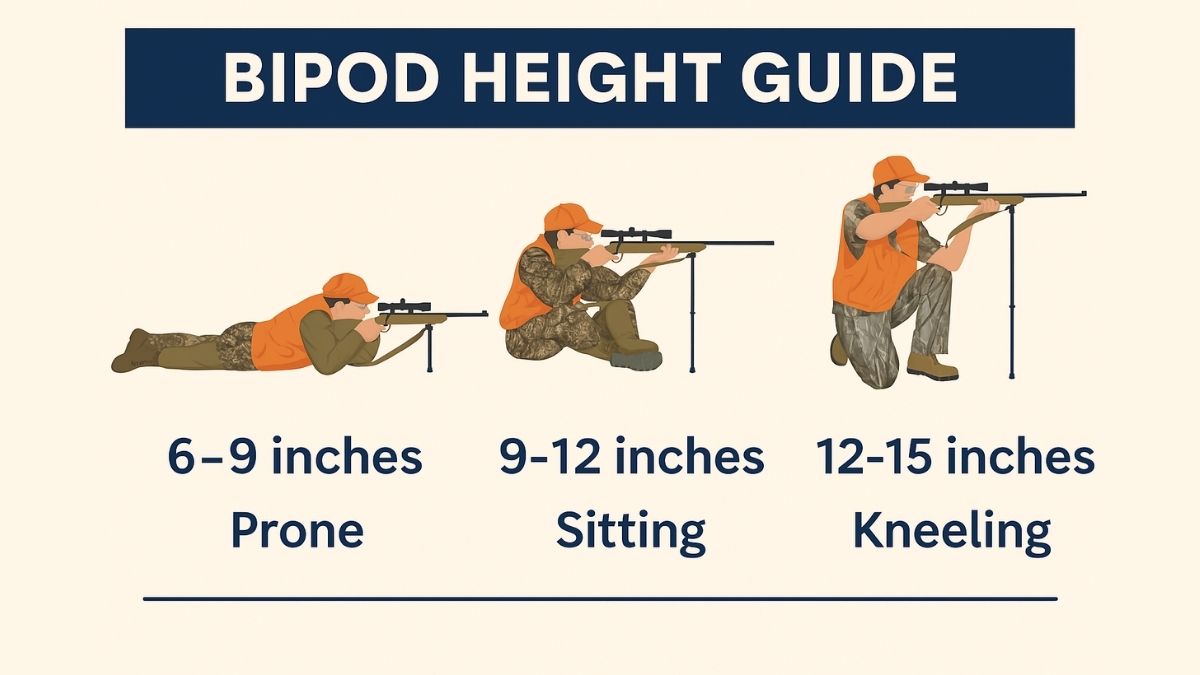
Mounting System
Picatinny rail mounts are common on tactical rifles like the AR15 or AR10. Sling swivel studs are standard for many hunting rifles, such as a Tikka T3x or Ruger Precision Rifle in a more traditional stock. Arca rails (RRS Arca) are popular in precision circles. Confirm your rifle’s fore-end compatibility before buying. If you have a bipod for a rifle without a rail, you might need an adapter or a clamp design.
Height Adjustability
Height is crucial for your shooting position. For prone or bench shooting, 6-9 inches is typical. For tall grass or sitting positions, consider bipods with extension up to 12 or even 62 inches (like the Vanguard). If you do long range shooting on varied terrain, a bipod that pivots or cants helps maintain a level reticle.
Material and Weight
Carbon fiber bipods (like Spartan) are ultra-light but cost more. Aluminum bipods strike a good balance. Steel options can be heavy but are extremely durable. Think about how far you plan to walk with your setup. A bipod that weighs too much can tire you out on extended hunts.
Leg Extensions and Lock Mechanisms
Some bipods have spring loaded legs; others use notches or friction locks. Spring loading is fast, but not everyone likes the “snap” it makes. Check for stable leg locks that won’t slip under recoil.
Price Range
Budget bipods, often under $100, can be surprisingly good for casual or moderate use.
Mid-range bipods like Harris or Magpul offer better build quality and features.
Premium options, Atlas bipods, MDT Ckye-Pod, Spartan bipod can cost quite a bit but often include advanced locking systems, multiple leg angle positions, and robust materials.
Final Thoughts
Finding the best rifle bipod isn’t just about brand names or trendy new features. It’s about matching a bipod to your style of shooting, your rifle’s mounting system, and your own comfort level in the field or at the range. If you plan on climbing hills and traveling light, you might lean towards a Spartan bipod or a compact CVLIFE. If you’re all about precision matches with a heavy rifle, an MDT Ckye-Pod or Atlas bipods could be your dream partner. In any case, the bipods above have shown me that even minor upgrades like better leg locks or more stable feet can translate to tighter groups and more ethical shots in hunting scenarios.
Good luck, and shoot straight.
FAQs
The “best” depends on your budget and shooting style. For instance, Atlas bipods excel in competition, whereas Spartan bipod stands out for its ultra-lightweight design.
Yes, a stable bipod can significantly improve accuracy by reducing muzzle drift and recoil movement. However, poor-quality bipods or ones not properly mounted can introduce wobble, ultimately hurting accuracy rather than helping it.
It depends on your typical shooting position. If you’re prone in short grass, a 6-9 inch bipod like a Harris S-BR works well. If you’re sitting in taller vegetation, consider something taller, such as the Vanguard Scout B62.
If you do a lot of field shooting or transition from prone to sitting frequently, invest in a bipod with range or quick leg extension features.
Spring loading can speed up deployment, but it can also make noise and lacks the fine control that friction-based systems provide. It’s a trade-off. If you prefer near-instant leg adjustments, a spring loaded system worth it.
We provide trusted insights for responsible, law-abiding firearm owners. We do not sell firearms. Some links may be affiliate links, meaning we earn a small commission at no extra cost to you. These commissions help support our product testing and honest reviews.